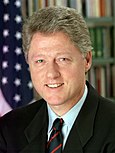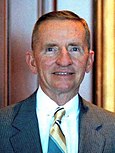U.S. presidential election, 1992
|
|
|||||||||||||||||||||||||||||||||||||
|---|---|---|---|---|---|---|---|---|---|---|---|---|---|---|---|---|---|---|---|---|---|---|---|---|---|---|---|---|---|---|---|---|---|---|---|---|---|
|
|||||||||||||||||||||||||||||||||||||
|
All 538 electoral votes of the Electoral College 270 electoral votes needed to win |
|||||||||||||||||||||||||||||||||||||
| Turnout | 55.2% |
||||||||||||||||||||||||||||||||||||
|
|||||||||||||||||||||||||||||||||||||
|
Presidential election results map. Blue denotes those won by Clinton/Gore, red denotes states won by Bush/Quayle. Numbers indicate electoral votes allotted to the winner of each state.
|
|||||||||||||||||||||||||||||||||||||
|
|||||||||||||||||||||||||||||||||||||
The United States presidential election of 1992 was the 52nd quadrennial presidential election. It was held on Tuesday, November 3, 1992. There were three major candidates: Incumbent Republican President George H. W. Bush, Democratic Arkansas Governor Bill Clinton, and independent Texas businessman Ross Perot.
Bush had alienated much of his conservative base by breaking his 1988 campaign pledge against raising taxes. The economy was in recession and Bush's perceived greatest strength, foreign policy, was regarded as much less important following the dissolution of the Soviet Union and the relatively peaceful climate in the Middle East after the defeat of Iraq in the Gulf War.
Clinton won a plurality in the popular vote, and a wide Electoral College margin. The election was a significant realigning election after three consecutive Republican landslides.Northeastern, Upper Midwest, and West Coast states which had previously been competitive began voting reliably Democratic. As of 2017, this is the most recent election in which an incumbent president was unseated, the previous one having been the 1980 election in which Ronald Reagan unseated then-incumbent Jimmy Carter.
...
Wikipedia





